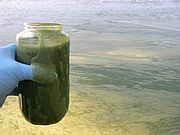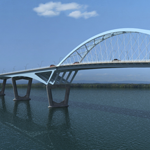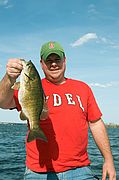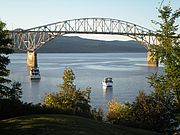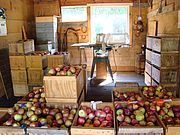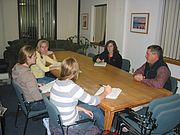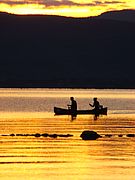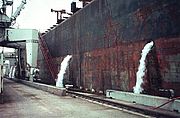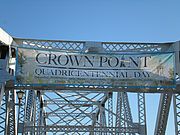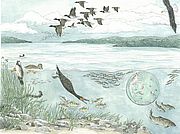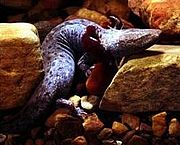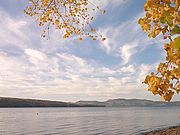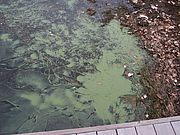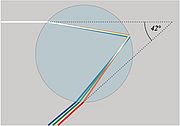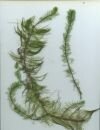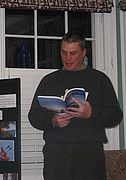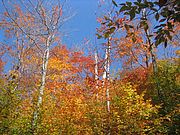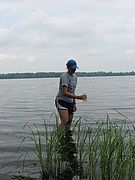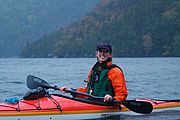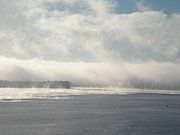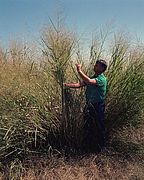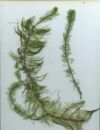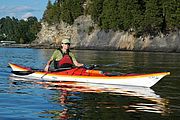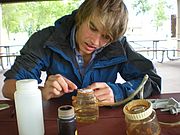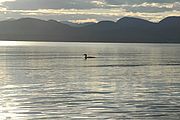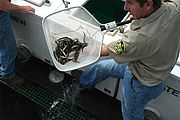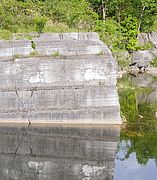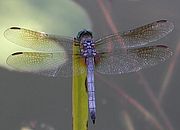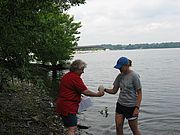My first car was a gray AMC Concord. Gray aptly described my mood when it made one of its frequent trips to the mechanic. On one of those occasions I was complaining to my father about how long it took to do the work. “Son,” he said, “you can have the work done well, done cheap, or done fast. Pick two.” No work is perfect; trade-offs need to be accepted.
Trade-offs exist with regard to water pollution too. The severity of different problems varies within Lake Champlain from lake segment to lake segment. Anglers are warned that eating too much fish can be bad for their health because of high mercury levels in the fish, and the mercury levels are likely to be highest in fish from the cold clear waters of the Main Lake. Algae blooms plague northern bays occasionally leading to beach closures. Invasive weeds infest the southern lake making boating and swimming difficult. Each part of the lake has issues that raise concern. However what people in one part of the lake perceive as a problem can actually minimize the other potential problems.
Read...
New York and Vermont officials are looking for input today on the design for the new Lake Champlain Bridge. Six designs for a replacement bridge have been proposed and you can vote for your favorite through midnight tonight. The 80-year-old Lake Champlain Bridge, which spans the state line between Crown Point, New York and Chimney Point, Vermont, was closed in October after inspections revealed it was structurally unsafe. State officials have determined that rehabilitating the bridge is not feasible given the extensive deterioration, moving the bridge location would entail too lengthy an environmental review process, and replacing it with a permanent ferry would not meet the needs of the community.
LCC is participating in the bridge review process. We are advocating for a thorough, thoughtful plan for both bridge demolition and construction that minimizes and mitigates environmental impacts, includes bike and pedestrian corridors on the new bridge, and ensures the design fits with the surrounding lake and landscape.
Six designs were unveiled at meetings held in Ticonderoga on Saturday. You can check them out on-line, complete a survey providing feedback on the alternatives and submit ideas on how to commemorate the historic bridge, which was shut down in October. The survey will only be available until midnight Monday December 14. We like the “Network Tied Arch Bridge” designs as the basket handle arch best emulates the pleasing lines of the old bridge, it complements and fits within the setting, and is less expensive and easier to maintain than some of the other proposals.
The old bridge will be demolished using explosives in the next several weeks. A new bridge is anticipated to be open by the summer of 2011 at a cost of roughly $65 million. Read...
Numerous bass fishing tournaments are held around the lake each year. A fish kill from a recent Plattsburgh event rekindled concerns about the number of fishing tournaments on the lake and raised questions about the impact to the bass fishery. To help guide discussions on this issue, the Lake Champlain Fisheries Leadership Institute Seminar Series is hosting a presentation by Dr. Bruce Tufts of Queen’s University in Ontario. Dr. Tufts is a recognized expert on Bass biology and catch and release fishing. The program is free and open to the public and will be held at the Cardinal Lounge at PSUNY’s Angell College Center. The program is sponsored by Lake Champlain Sea Grant, Great Lakes Research Consortium, and the Lake Champlain Research Institute. For more information contact timothy.mihuc@ plattsburgh.edu at SUNY Plattsburgh’s Lake Champlain Research Institute or mark.malchoff@ plattsburgh.edu at Sea Grant. Read...
New York Governor David A. Paterson and Vermont Governor Jim Douglas have received a report from their states' respective transportation agencies which finds that it is not feasible to rehabilitate the Champlain Bridge. Engineers have declared that the 80-year-old span is too unstable to be renovated, and recommend demolishing the bridge for the safety of motorists and boaters. The Federal Highway Administration is expected to concur with the recommendation based on their preliminary review of the report. Transportation officials anticipate building a new bridge as close as possible to the current location. Read...
As you go about your food preparations for Thanksgiving and other upcoming holidays, consider supporting local farmers. If you live in the Champlain Valley, finding eggs, butter, cheese, cream and milk and even poultry produced nearby is fairly easy regardless of the season. However, local beets, potatoes, onions, garlic, carrots, pumpkins, squash, apples and other staples are often available even into November and December. Providing a meal where most of the food comes from within a 30-mile radius of home can deepen the meaning of Thanksgiving.
According to the Vermont Department of Agriculture, shifting just 10% of food purchases to locally grown food products, would add more than $100 million to the state’s economy. Any day of the year buying local foods offers thanks for the bounty we share living in the Champlain Valley. Read...
Why do clouds hang low over the lake on autumn mornings?
Where do invasive species come from and how do they arrive?
How might global warming affect Lake Champlain’s future?
How did the lake get here?
Hundreds of University of Vermont students are learning the answers to these and many more questions through LCC’s award-winning book Lake Champlain: A Natural History. The book is required reading this semester in Dr. Larry Forcier’s Natural History and Field Ecology class where students learn about the dynamics of the natural world.
You can join in the lake learning too by purchasing a copy of the book through LCC’s secure online Lake Shop. The 160-page illustrated publication covers the lake’s geology, geography, biology, and ecology in an accessible, engaging style. It makes a great gift for friends, family, fellow lake lovers or yourself! Read...
Sometime in November or December those who spend time on the lake in quiet contemplation might notice the normally clear water becomes murky, despite the absence of rain. A stale rotten smell may fill the air, even though the summer's algae blooms are long since passed. Lake Champlain will be in the midst of one of its twice yearly mixings. The mixing, also called turnover, occurs because, the water column in a given section of the Lake is of uniform temperature for the first time since spring.
During the summer months the Lake is layered, less dense and warm above, more dense and cool below with a sharp transition, a thermocline, somewhere in the middle. So long as the upper warm layer absorbs heat the temperature and density differences between the layers is accentuated. In addition to temperature differences, the cool bottom layer has less oxygen. Fish and other creatures take oxygen from the water and, because this layer is trapped below the warm layer above and not in contact with the air, the supply is never replenished.
Read...
Each year thousands of ships move between the Great Lakes and the Atlantic Ocean. Some carry more than cargo and crew; they hide animals or plants from distant lands. A new invasive species is found in the Great Lakes every 28 weeks on average. While throughout history species have expanded their ranges, only in modern times has such movement between continents, assisted by humans, been so easy and so frequent.
Species that arrive in the Great Lakes don’t necessarily stay there. They travel, often eastward toward Lake Champlain. Intercontinental traffic brought zebra mussels to the Great Lakes, the original introduction point for all North American populations. Zebra mussels made their way through canals or attached to other boats, reaching Lake Champlain by the early 1990s, ten to fifteen years after first being seen in the Great Lakes.
Read...
In late September, LCC celebrated its 46th annual meeting as part of the Crown Point Quadricentennial and Festival of Nations. The Crown Point Bridge was an integral part of the bi-state events. Thousands of participants crisscrossed the lake in cars and on foot to take in music, theater, films, and natural and cultural history programs at Chimney Point and Crown Point State Historic sites. Less than a month later, the bridge was abruptly closed indefinitely when inspectors discovered that at least two of the 80-year old concrete piers were in danger of collapse.
The effect was immediate and severe in an area where people live on one side of the water and work on the other, farms straddle state lines, and businesses have been built around cross lake traffic. Commutes have more than doubled in time and money, employees have been laid off, and some people have resorted to boating across the lake in the dark to get to and from work.
The bridge symbolizes the connectedness of Champlain Valley residents. Its closure has brought to light one fact that sometimes gets ignored – our shared reliance as a lake community. What happens on one side of the water affects the other. Recognition of our interconnectedness will not only help us address the transportation challenges at hand but should also inform all our environmental policy decisions from reducing nutrient loading to combating invasive species. Read...
Check out LCC’s Lake Shop for the perfect present for a fellow lake lover. We have lake note cards, art prints, and a great natural history book to help you celebrate friendships, thank a host, stuff stockings, and remember the holidays. You can also give a gift membership. Recipients of a $40 membership will be notified of your gift in December and sent the 2010 Lake Champlain Paddlers’ Trail Guidebook in June. Recipients of a $55 membership will receive an autographed copy of LCC’s award winning natural history book in December and the 2010 trail guidebook in June. Just fill out the online new membership form, check the “gift membership” box, and we’ll do the rest! Read...
The largest known population of mudpuppies on Lake Champlain was found recently in the Lamoille River when over 500 of the reclusive nocturnal amphibians were killed by chemicals added to the river to kill sea lamprey. It is unknown how many mudpuppies survived. Mudpuppies, particularly juveniles, are known to be susceptible to the lampricides and have been affected by many treatments around the lake. Fewer than 200 mudpuppies were killed in the largest prior die-off on the Ausable River.
Mudpuppies are large salamanders that never lose their external gills. They spend their entire lives in the water and populations are extremely difficult to survey. They feed principally on small invertebrates. They are long-lived and do not reproduce until they are about six years old. The first mudpuppy ever described by science came from Lake Champlain. In 2002 the state of Vermont’s Reptile and Amphibian Species Advisory Group recommended that mudpuppies be listed as threatened in Vermont, but the Agency of Natural Resources did not accept that recommendation.
Read...
LCC Staff Scientist Mike Winslow will discuss the historic and on-going cooperative efforts to protect Lake Champlain. Learn more about the lake, what is being done to restore its health, and how you can make a difference in Lake Champlain’s future, during this free evening program. Click here for directions to Hawkins Hall. Co-sponsored by the Lake Champlain Committee and the Lake Champlain Research Institute.
Can’t attend but want to learn more about Lake Champlain?
Purchase a copy of LCC’s award-winning natural history book through our Lake Shop.The 160-page publication covers the lake’s geology, geography, biology, and ecology in an accessible, engaging style. It makes a great gift for friends, family, fellow lake lovers or yourself! Read...
Keep the lake in mind when loading your automatic dishwasher and use phosphorus-free detergent. Check the labels on the products you buy to ensure the brand you choose doesn’t include phosphorus to avoid sending excess nutrients into our waterways.
Research and lobbying by LCC led to passage of legislation in Vermont to ban phosphates from household dishwasher detergents in 2010. Similar legislation in NY was introduced earlier this year (S.3780 and A.8914) but has not yet passed. According to independent studies by Consumer Reports, phosphate-free automatic dishwasher detergents work as well as those with phosphates.
For more lake friendly tips, check out the Learn and Get Involved sections of our website and consider taking our Lake Protection Pledge. Read...
As summer fades to winter blue-green algae blooms become but a memory. But what actually happens to the algae? Well, it depends on the species. Some blue-green algae produce specialized resting cells called akinetes that settle to the bottom of the lake and essentially hibernate through the winter. Development of akinetes is triggered by both declining light levels and declining temperature. Other blue green algae produce colonies that are either buoyant or not. As winter approaches, change in light and water temperature lead to an increase in proportion of non-buoyant colonies. These cells settle to the bottom where they continue to remain active and even divide, though at a much reduced rate. Come spring, when wind and wave stir the bottom sediments, the algae are re-suspended. Models developed in the Netherlands suggest that if there were no recruitment of algae from the bottom, summer blooms would be reduced by 50%. Read...
In early October, a rare meteorological phenomenon provided a treat for people lucky enough to be near the Crown Point Bridge. The waters north of the bridge became suffused with rainbow colors. Though everyone is familiar with rainbows arcing in the sky, seeing them sitting atop the water is much less common.
Rainbows form when the sun’s rays pass through water droplets and reflect back to an observer. Once the light enters the water droplet it bends, with different wavelengths varying in the degree to which they are bent. Reds bend 42 degrees while blues bend about 40 degrees. The light then bounces off the back of the water. Thus in order to see a rainbow, light must shine from behind the observer while water droplets are in the air in front of the observer.
In order to see the different colors of the rainbow, light must reflect off different water droplets. Those slightly higher in the atmosphere reflect reds, while the lowest droplets reflect blues.
Read...
Aquatic biologists at Vermont’s Agency of Natural Resources (ANR) found a population of the invasive plant, variable-leaved watermilfoil, in the southern end of Missisquoi Bay. Similar to the native whorled watermilfoil, a rare plant species in the state, the variable-leaved watermilfoil was confirmed by genetic analysis this week from samples pulled during a routine water chestnut search last month in the bay.
Though variable-leaved milfoil is known in the Adirondacks, Lake Champlain is only the second confirmation of the species in Vermont. The first was found in Halls Lake in Newbury in 2008. The invasive plant has also been found in Massachusetts, New Hampshire and Quebec waters.
Read...
Join LCC Staff Scientist Mike Winslow at the Lake Champlain Maritime Museum at Basin Harbor, Vermont on Thursday, October 1 for a provocative lake presentation. Learn about the forces that shape the lake, the creatures that call it home, the phenomena that add to its mystery, and what you can do to protect its future. The lecture is free and open to all so bring friends and family. Click here for directions to the Museum. Read...
While raking leaves and puttering around the house this fall, check the nearest stormdrain to be sure it too is free of debris. Plugged stormdrains prevent water from entering the storm sewer. Instead, the water starts eroding its own path to the nearest stream, and thus creates even more pollution.
One way to be sure the leaves you rake don’t contribute to clogging stormdrains is to compost them. Use your lawnmower to shred the leaves. If you have a bagger attachment the shredded leaves can be collected. Otherwise, use the blower on the motor to accumulate leaves. In either case the leaves make excellent mulch, or they can be added to a compost pile.
For more lake friendly tips, check out the Learn and Get Involved sections of our website and consider taking our Lake Protection Pledge. Read...
LCC wrapped up our 7th algae monitoring season just after Labor Day. Overall, although patchy blooms continued in Missisquoi Bay and sporadic blooms popped up in other parts of the lake, the frequency and intensity of blooms was lower this summer than in most past monitoring seasons. LCC staff identified a bloom in Kelly Bay at the far north end of the lake by the Rouses Point Bridge, an unusual place for such blooms. Though it is well known that high nutrient levels promote algae blooms, the exact triggers that determine when and where blooms occur are still unclear. The monitoring program is a key to efforts to identify toxic blooms, protect public health, and work for solutions.
Sincere thanks to the Lake Champlain Basin Program for funding support, our program partner Dr. Mary Watzin of the University of Vermont Rubenstein Ecosystem Science Laboratory and our faithful 2009 season monitors for their weekly wading into the water: Jennifer Bowman, Sally and Jim Brabham, Bryan Burke, Al Carpenter, Chris Case, Carson Cornbrooks, Deborah Diemand, Marc Eisenhower, David Greenough, Bill Magnus, Robert Martell, John McBride, Gary Molinski, Bob Murphy, Martha Perry, Larry and Jeanine Pratt, Mike Roach, Micah Rose, Julia Smith, Mark Sweeney, and Doug Ward.
Click here for an overview of the seasons monitoring results or go to www.lakechamplaincommittee.org/lcc-at-work/algae-in-lake/ and scroll to the bottom of the page. Read...
Foliage season, bird migrations and the serenity of a near empty lake all beckon the fall paddler. It can be a wonderful time to be on the water – if you’re well prepared. The cooler fall temperatures require a wet suit or dry suit. Any time the combined air and water temperatures are less than 120 degrees F, you should wear this extra gear under your Personal Flotation Device (PFD). You’ll also need lots of fuel to maintain your core temperature and reinvigorate tired muscles so be sure to bring lots of water and carbohydrate-rich snacks with you. Be cautious about heading out and make sure you, your boat and your group are properly equipped:
- Plan your trip ahead of time and make sure it matches the mental and physical skill set of your entire party.
- Leave your itinerary with a responsible onshore contact.
- Be aware of the wind, water and weather conditions before you depart.
- Bring a weather radio or VHF with you, check the weather forecast repeatedly, and adjust your travel plans accordingly.
- Always wear a Personal Flotation Device (PFD). Nine out of ten drownings occur in inland waters, most within a few feet of safety. Most of the victims owned PFDs but died without them. A properly fitted, buoyant PFD can save your life, only if you wear it.
- Wear a wetsuit or drysuit with an insulating layer and a hat that stays put. Dress for the season in layers of synthetic fabric to prevent getting overheated and chilled from perspiration or water.
- Pack extra dry clothing in a sealed bag.
- Test your gear in advance in a controlled cold water environment to learn how much protection it provides.
- Paddle near to shore and near others who can help you in the event of capsize.
- Make sure you have the skills to travel to and from shore and shelter.
- Ensure that everyone in your paddling party knows the signs and symptoms of hypothermia before you set out.
- Stay aware of all boat traffic.
- Fuel your body with high carbohydrate foods and lots of water.
We love to hear about our members’ outings! Please send pictures and tales from the water to: lcc@ lakechamplaincommittee.org. Read...
Throughout cold autumn evenings, the layer of air closest to the Lake Champlain’s water accumulates moisture and warmth. The moisture condenses and a thick steam fog forms with colder air masses generating thicker fogs. As the strengthening sun continues to warm the air, wisps of cloud flow upward, revealing the air’s convection currents. A layer of fluffy clouds hovers, seemingly suspended between the water and the otherwise azure blue sky. These clouds mark the border between the lake-warmed water and the cold air mass above. Eventually, the day’s sun warms all the air and the fog burns off. Click on the title to learn how steam fog played a key role in a pivotal Revolutionary War battle. Read...
The future will not look like the past. Such is true for the lake and the landscape. Rather than trying to recreate some hypothetical past utopia, we need to work towards a mutually desirable future state that is better than what we have. Agriculture may present the most significant opportunity today for envisioning and moving toward a desirable future state. Currently, agriculture in the Lake Champlain Basin is dominated by dairy production, but that may not be true in the future.
The dairy industry presents inevitable challenges to water quality. Cows produce manure which is high in phosphorus and bacteria. Cows, at least during the winter and on larger farms, eat corn, an annual crop that leaves much of the soil exposed and susceptible to erosion. Corn and other crops used to feed cows require inputs of additional phosphorus fertilizer which is a pollutant when it gets to the lake. Cows that are pastured instead of eating corn have a tendency to trample vegetation in their search for drinking water, directly contributing to erosion. All of these challenges can be managed and minimized, but they can not be eliminated.
Read...
Variable leaved-milfoil, a new invasive species in Lake Champlain, has been confirmed in Missisquoi Bay. Variable-leaved milfoil is closely related to Eurasian watermilfoil which already infests much of the lake. Click the headline for more information. Read...
LCC and the University of Vermont are collaborating on a recreational study for the Lake Champlain Paddlers Trail. Surveys were sent this summer to all LCC members who receive our annual Paddlers’ Trail guidebook. Thanks to everyone who has responded. If you haven’t returned your survey yet, please set aside some time this week to give us feedback on the Trail. By sharing your paddling experiences, what you value about getting out on the water, and your thoughts on what enhances or diminishes your recreational experience, you will help guide management of sustainable boating on Lake Champlain. We value your input and need your help! Read...
LCC volunteers have been hard at work collecting water samples to identify algae blooms around Lake Champlain. This summer has been relatively quiet. The thick pervasive bloom often seen in the lake’s northeastern bays has been less prevalent than in years past although a patchy bloom has developed in Missisquoi Bay, particularly in the eastern portion, and occasional short term blooms cropped up in other areas. Monitoring efforts continue through the Labor Day weekend. Click here for an overview of the seasons monitoring results or go to http://www.lakechamplaincommittee.org/lcc-at-work/algae-in-lake/ and scroll to the bottom of the page. Read...
If you see lights out on Lake Champlain in the next few weeks it’s probably not UFOs. The Adirondack Cooperative Loon Program will be conducting night time surveys of loons on Lake Champlain. Researchers have found that going out at night with spotlights allows them to sneak up on the birds and trap them with nets. They can then take blood samples to check for mercury and lead levels and evaluate immune response. They also tag the birds in order to track where they come from and where they are going. The project is a cooperative effort between the NY Department of Environmental Conservation, the Biodiversity Research Institute, and the Wildlife Conservation Society. Read...
The Vermont Fish & Wildlife Department gave its recently-established muskellunge restoration effort a boost in August when it stocked 250 four-month old muskellunge in the Missisquoi River Delta. The fish were donated by the New York State Department of Environmental Conservation.The muskellunge, related to northern pike, but larger, is a prized sport fish. Lake Champlain and the Missisquoi River are the only locations in New England that historically had a native muskellunge population. Muskellunge were native to Lake Champlain’s Missisquoi River and Missisquoi Bay but the population that last existed upstream of the Swanton Dam was apparently lost in the late 1970s following a chemical spill that occurred on the upper river. Read...
Imagine sitting in a lounge chair with your feet in the water looking out over a tropical sea. The sun blazes away and the reefs around you teem with life. There was a time, nearly half a billion years ago, when the area we now call Lake Champlain hosted such an environment. This was before life existed on land, before the bedrock of the region had even formed.
At the time, the continental plate upon which Lake Champlain sits today was located in the lower latitudes of the Southern Hemisphere. Carbon dioxide levels exceeded today’s levels by 14 to 16 percent, and the earth was so warm that practically no ice existed. As a result, sea levels were much higher and the continental shelf was covered by a shallow arm of the Iapetus Ocean. In this arm, some of the world’s earliest reefs developed. Read...
Their names can evoke spine-chilling fear - bog haunter, pond hawk, shadow dragon, widow skimmer - or elfin magic - jewel wing, aurora dancer, sedge sprite. They are the subject of old wives tales about sewn lips of misbehaved children or their ability to reincarnate snakes. Few animal groups inspire more colorful stories than dragonflies and damselflies. Yet, even if the wives tales are not true and the names are only fanciful, these insect masters of the sky still lead fascinating lives. Together, dragonflies and damselflies comprise the insect order Odonata or “toothed ones”. Generally, dragonflies are faster and larger than damselflies, but the most reliable visual difference between the two groups is how they hold their wings when resting. Dragonflies hold their wings horizontal to the ground while most damselflies hold theirs perpendicular. Both groups are predators as adults and nymphs. Read...
LCC kicks off its seventh year of algae monitoring around Lake Champlain on July 6th. Water samples are taken weekly by volunteers around Lake Champlain and the results are analyzed by UVM’s Rubenstein Ecosystem Science Laboratory. LCC coordinates volunteer efforts and transports samples to UVM for analysis. Monitoring continues through the Labor Day holiday.
If you see algae blooms outside Missisquoi Bay, St. Albans Bay or the Alburg Passage, first check out LCC’s pamphlet on floating phenomena (pdf) and then contact us at lcc@ lakechamplaincommittee.org for guidance on collecting a sample for identification. Read...

